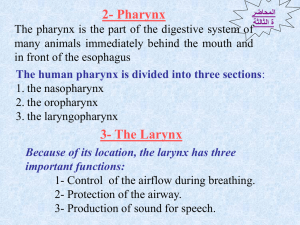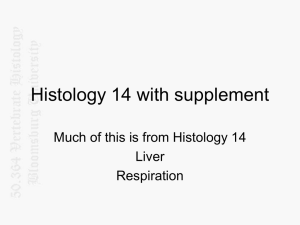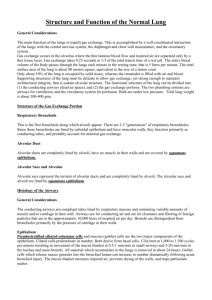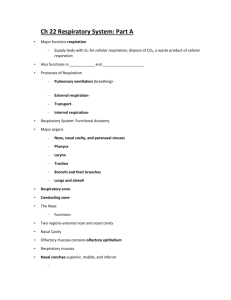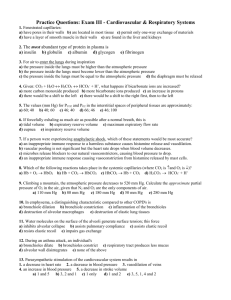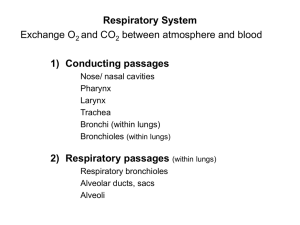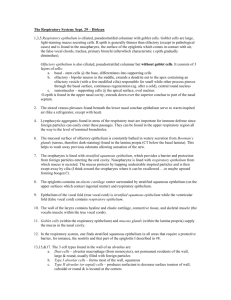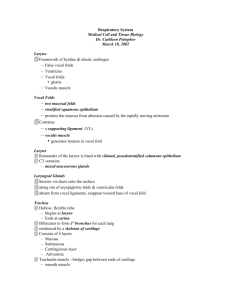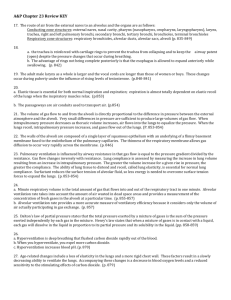02 Integrated Respiratory II (1432
advertisement
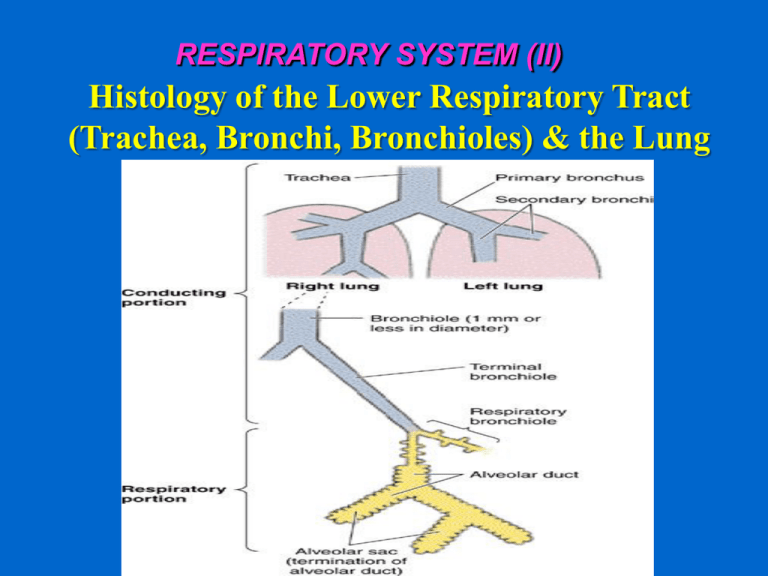
RESPIRATORY SYSTEM (II) Histology of the Lower Respiratory Tract (Trachea, Bronchi, Bronchioles) & the Lung Objectives: By the end of this lecture, the student should be able to describe: 1- The microscopic structures of the wall of: • • • • Trachea. Primary or extrapulmonary bronchi. Intrapulmonary (secondary and tertiary) bronchi. Bronchioles. 2- The microscopic structures of : Interalveolar septum. Alveolar phagocytes. Pleura. TRACHEA The wall of trachea is formed of: (1) Mucosa. (2) Submucosa. (3) Adventitia. MUCOSA OF TRACHEA (1) Epithelium: Respiratory epithelium (2) Lamina propria. (3) Elastic lamina: It is formed of elastic fibers. It separates lamina propria from submucosa. SUBMUCOSA OF TRACHEA Contents: 1- C.T. 2- Numerous mucous & seromucous glands. 3- Lymphoid elements. ADVENTITIA OF TRACHEA Contents: 1- Fibroelastic C.T. 2- C-shaped rings (12-16) of hyaline cartilage. Trachealis muscle (bundle of smooth muscle fibers) connects the 2 ends of each C-shaped cartilage. EXTRAPULMONARY BRONCHUS (1ry BRONCHUS) Generally have the same histological appearance as the trachea. INTRAPULMONARY BRONCHI (2ry & 3ry BRONCHI) 1234- Mucosa. Muscle coat. Submucosa. Adventitia. INTRAPULMONARY BRONCHUS (1) Mucosa: a- Epithelium: Respiratory epith. b- Lamina propria. N.B. No elastic lamina. (2) Muscle coat (complete): Two distinct layers of smooth muscle fibers spirally arranged in opposite direction. INTRAPULMONARY BRONCHUS (3) Submucosa: C.T. contains: a- Seromucous glands. b- Lymphoid elements. (4) Adventitia: Contents: a- Loose C.T. b- Irregular plates of hyaline cartilage (complete layer). c- Solitary lymphoid nodules. BRONCHIOLES 1- Preterminal ( 1ry ) Bronchioles (Bronchioles): Are less than 1mm in diameter. 2- Terminal ( 2ry ) Bronchioles. 3- Respiratory ( 3ry ) Bronchioles. Preterminal Bronchioles (1) Mucosa: has longitudinal folds: A- Epithelium: Simple ciliated columnar epith. with occasional goblet cells. B- Lamina propria: C.T. rich in elastic fibers. (2) Smooth muscle: 2 helically arranged smooth muscle layers. (3) Adventitia: C.T. N.B. No cartilage, No seromucous glands, No lymph nodules. Terminal Bronchioles Similar structure to preterminal bronchioles, but: Epithelium: Simple cuboidal partially ciliated epithelium With Clara cells ( With NO goblet cells). N.B. Are less than 0.5mm in diameter. Respiratory Bronchioles Are similar in structure to terminal bronchioles But: their walls are interrupted by the presence of few pulmonary alveoli. CLARA CELLS Structure: columnar cells (non ciliated). Function: 1- Degrade toxins in inhaled air. 2- Divide to regenerate the bronchiolar epith. 3- Produce surfactant-like material. ALVEOLAR DUCTS The wall of alveolar ducts consist almost of pulmonary alveoli. N.B. Alveolar duct → ends by: atrium → communicates with: 2-3 alveolar sacs PULMONARY ALVEOLI Definition: They are small outpunching of respiratory bronchioles, alveolar ducts & alveolar sacs. Topics: *Interalveolar septa. *Alveolar epithelium. * Alveolar phagocytes (Lung macrophages). INTERALVEOLAR SEPTA Definition: The region between 2 adjacent alveoli. Components: (A) Alveolar Epithelium: lines both sides of interalveolar septum. (B) Interstitium. ALVEOLAR EPITHELIUM (1) Type I Pneumocytes (2) Type II Pneumocytes ALVEOLAR EPITHELIUM (1) Type I Pneumocytes: - line 95% of the alveolar surface. - Count: less numerous than type II pneumocytes. - L/M: simple squamous epith. -Function: Exchange of gases. (2) Type II Pneumocytes: - Line 5% of the alveolar surfaces. - Are more numerous than type I pneumocytes. - Are cuboidal or rounded cells, With Foamy cytoplasm. Nucleus: central & rounded. - The cytoplasm contains membrane-bound Lamellar bodies (contain pulmonary surfactant). Type II Pneumocytes: Function: 1- Synthesis & secretion of pulmonary surfactant. 2- Renewal of alveolar epithelial cells: Type II cells can divide to regenerate both type I & type II pneumocytes. Interstitium of interalveolar septa (1) Continuous Pulmonary Capillaries. (2) Interstitial C.T.: a- C.T. Fibers: elastic fibers & type III collagen (reticular fibers). b- C.T. Cells: Fibroblasts, Macrophages, Mast cells, Lymphocytes. BLOOD-GAS BARRIER (BLOOD-AIR BARRIER) Definition: It is the region of the interalveolar septum that is traversed by O2 & CO2 Components: 1- Thin layer of surfactant. 2- Type I pneumocyte. 3- Fused basal laminae of type I pneumocytes & endothelial cells of the pulmonary capillary. 4- Endothelial cells of the pulmonary capillary. Alveolar phagocytes (Alveolar Macrophages) (Dust Cells) Sites: (1) In the lumen of pulmonary alveoli. (2) In the interstitium of interalveolar septa. Function: Phagocytose particulate matter (e.g. dust) & bacteria in the lumen of pulmonary alveoli and in the interstitium of interalveolar septa. Pleura Is formed of two layers: Parietal and visceral. It is formed of simple squamous mesothelium. The two layers are separated by serous fluid. The visceral layer has sub-epithelium loose C.T that extends into the lung tissue THANK YOU
